Effects of Processing on Physicochemical and Antinutritional Properties of Black Turtle Bean (Phaseolus vulgaris L.) Seeds Flour
S. S. Audu1*, M. O. Aremu2 and L. Lajide3
1Department of Chemistry, Nasarawa State University, PMB 1022, Keffi, Nigeria 2Department of Chemical Sciences, Federal University Wukari, PMB 1020, Taraba State, Nigeria 3Department of Chemistry, Federal University of Technology, PMB 704, Akure, Nigeria
DOI : http://dx.doi.org/10.13005/ojc/290318
Article Received on :
Article Accepted on :
Article Published : 28 Oct 2013
The black turtle bean (Phaseolus vulgaris L.) is popular among the people of Bokkos in Plateau State, Nigeria where it is cultivated and locally known as “Kwakil”. The effects of different processing methods (boiling, cooking, roasting, sprouting and fermenting) were investigated on fatty acid composition, physicochemical parameters and antinutritional factors of black turtle bean seeds. All the analyses were carried out using standard analytical techniques. The results showed that oleic acid and linoleic acid were the most concentrated fatty acids in the raw and processed samples with values ranging from 27.7 to 30.8% and 54.7 to 64.0%, respectively. Capric, lauric and myristic acids were present in small quantities with maximum value of 1.6% in roasted sample. Unsaturated fatty acids predominated in all the samples with an adequate amount of essential fatty acids. Significant differences were observed (p<0.05) in the fatty acid compositions between the raw and processed seed samples. The results of physicochemical properties of the seed oils for all the samples showed mean range values of the following parameters: Saponification value (190.5 – 198.05 mg KOH/g), peroxide value (3.20 – 3.42 meq O2/kg), iodine value (136.4 – 146.4 mg of I/100g, acid value (10.40 – 10.78 mg KOH/g), kinematic viscosity at 100oC (8.12 – 8.44 mm2/s), specific gravity at 25oC (0.96 – 0.97), unsaponifiable matter (3.37 – 3.62%) and flash point (302 – 315oC). Generally, the values of the physicochemical parameters showed that the oils may be useful as edible oils due to their stability as frying oils. The results of antinutrients revealed that reductions were almost recorded in all the processed seed samples compared with the raw sample.
KEYWORDS:Black turtle beans;processing;fatty acids;physicochemicals;antinutrients
Download this article as:| Copy the following to cite this article: Audu S. S, Aremu M. O, Lajide L. Effects of Processing on Physicochemical and Antinutritional Properties of Black Turtle Bean (Phaseolus vulgaris L.) Seeds Flour. Orient J Chem 2013;29(3). doi : http://dx.doi.org/10.13005/ojc/290318 |
| Copy the following to cite this URL: Audu S. S, Aremu M. O, Lajide L. Effects of Processing on Physicochemical and Antinutritional Properties of Black Turtle Bean (Phaseolus vulgaris L.) Seeds Flour. Orient J Chem 2013;29(3). Available from: http://www.orientjchem.org/?p=292 |
INTRODUCTION
Recent problems linked to meat consumption have also led to renewed interest in vegetarian diet. This phenomenon is reinforced by the fact that physicians have pointed out that consumers eat too many animal products (rich in saturated fat) and no enough plant foods1. The consumption of a great deal of meat increases the risk of cardiovascular diseases and some types of cancer. Therefore, the utilization of seed flour and plant proteins as functional ingredients in food system continued to be of research interest especially in legumes.
Furthermore, legumes are known to be superior in terms of the provision of protein without cholesterol, fibre and minerals such as calcium, magnesium and potassium2. Legumes like other foods for human and animals provide some life sustaining elements. These elements are the nutrients that supply energy after being metabolized in the body and are essential for the body to carry on this metabolism3. Despite these useful constituents that are present in these seeds, its utilization has been ignored because it has been established that there are compounds or substances which act to reduce nutrient intake, digestion, absorption and utilization4. They include tannins, saponins, phytates, flavonoids, alkaloids, cyanogenic, glycosides, etc. Some workers5 noted that some tropical seeds are high in antinutrients which limit their utilization in food system. Due to effect of these metabolites resulting in food poisoning, there is need to properly address this problem in Nigeria, and indeed in most parts of the developing countries that feed mostly on legumes and other vegetable based diets. This is because people have died of ignorance, poverty and inadequate nutrition education, especially with the African society.
The objective of the present study was to investigate the efficiency of processing methods, such as boiling, cooking, roasting, sprouting and fermenting on the fatty acid composition and some physicochemical parameters of black turtle been seed oils as well as antinutritional components of the seeds flour with a few to providing preliminary information towards effective utilization of this crop in various food applications in Africa and other parts of the world.
MATERIALS AND METHODS
Sample Collection
Mature seeds of black turtle been (Phaseolus vulgaris L.) were purchased in September, 2011 from a local farmer in Bokkos town, Bokkos Local Government Area of Plateau State, Nigeria. The seeds were identified at the Herbarium of the Nutritional institute of Pharmaceutical Research and Development (NIPRID) Idu, Abuja, Nigeria.
Sample Preparation
Raw seeds
About 600 g of the raw seed were soaked in ordinary water and manually dehulled and dried in an oven at a temperature of 50oC.
Sprouted seeds
Some of the raw seeds (100 g) were allowed to germinate using a method described by Giami and Bakebain6. The seeds were arranged in layers on the sawdust in a locally woven reed basket, wetted daily and observed for sprouting for a period of 3 – 4 days. Seeds with sprouts about 1 cm long were picked, washed with distilled water, and dehulled, sliced and oven dried at 50oC.
Roasted seeds
One hundred grams of the raw seeds were manually dehulled and roasted on a hot cast iron pan at a temperature of 45 – 55oC. The seeds were continuously stirred until a characteristic brownish color was obtained which indicated complete roasting. The seeds were cooled in desiccators and kept for further analysis.
Fermented seeds
The dehulled seeds (100 g) were wrapped in blanched banana leaves and allowed to ferment for 4 days6. The sample was then removed, dried in an oven at a temperature of 50oC till well dried.
Boiled seeds
The raw dehulled seeds were boiled for 45 min in distilled water at 100oC. The boiled seeds were drained using a perforated basket, after which they were dried in an oven at 50oC until well dried.
Cooked seeds
The raw dehulled seeds (100 g) were cooked with distilled water using an aluminium pot for 90 min. It was then poured into a perforated basket to drain the water. It was later dried at a temperature of 50oC in an oven.
After all processing treatments were completed all the raw and processed seed samples were ground into fine powder using a Kenwood blender. The flour samples were then kept in airtight containers and stored in a deep freezer (–18oC) prior to chemical analyses.
Extraction of oils
The dried sample was extracted in Soxhlet apparatus with redistilled n–hexane of Analar grade (BDH, London) for the recovery of undiluted oil. The crude oil extract was made to be free of water by filtering through the anhydrous sodium sulphate salt. The hexane was removed from the oil/hexane mixture by sung a rotary evaporator.
Fatty acid analysis
The oil extracted was converted to the methyl ester7. About 2 mg crude oil sample was transferred into a 5 – 10 ml glass vial and 1 ml of diazomethane ether solution added. The mixture was shaken thoroughly and allowed to stand for 1 min. then 16 µL of 3.33M CH3COONa/CH3OH solution was added; mixture shaken and allowed to stand for 10 min after which 10 µL acetyl acid was added. The equation of the transmethylation is shown below:
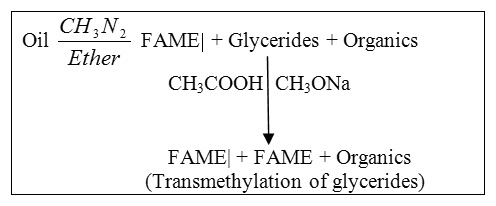
The fatty acid methyl esters were analyzed using a HP 6890 gas chromatograph powered with HP Chemistation Rev. a 09.01(1206) software fitted with a flame ionization detector and a computing integrator. Nitrogen was used as the carrier gas. The column initial temperature was 250oC rising at 5oC/min to a final temperature of 310oC while the injection port and the detector were maintained at 310oC and 350oC, respectively. a polar (HP INNO Wax) capillary column (30 m x 0.53 mm x 0.25 µm) was used to separate the esters. The peaks were identified by comparison with standard fatty acid methyl (St. Louis, MO, USA)
Physicochemical analyses
The physicochemical analyses of the oils for saponification value, peroxide value, iodine value, acid value, kinetic viscosity, specific gravity, unsaponifiable matter, and flash point were carried out according to the methods of AOAC8.
Antinutritional factors determination
The contents of saponin, tannin, alkaloid, trypsin inhibitor, phytate, oxalate and cyanide were determined by methods described by some workers9 – 10.
Statistical evaluation
The statistical calculations included percentage value, grand mean, standard deviation and relative standard deviation (RSD).
RESULTS AND DISCUSSION
Fatty acid Composition of Black Turtle Bean
The fatty acid composition of raw and processed seeds of processed black turtle bean is shown on Table 1. Linoleic acid (C18:2ω6) had the highest concentration with values ranging from 54.7% in roasted to 64.0% in raw samples with an average value of 60.4±3.48%, oleic acid (C18:1ω9) is second with values ranging from 27.7% in sprouted to 30.8% in roasted with average of 29.3±1.19% and palmitic acid (C16:0) is in the third position with values ranging 4.5% in fermented seed to 6.5% in roasted seeds, with average of 5.6%±0.90. The observation in this report is in agreement with reports of some workers as follows: That linoleic (C18:2ω6) was the most concentrated fatty acid in pinto bean (62.9%)11, soybean (52.0%)12, red kidney bean (50.3%)5, corn oil (55.7%), safflower oil (72.6%)13, and sponge luffa oils (54.32%)14, but slightly higher than that reported for small black variety of kidney bean (44.3%), cowpea (39.3%) and lima bean (41.0%)15. Many lipids from legume seeds contain substantial amounts of saturated fatty acids, especially palmitic acid16. A high proportion of either linoleic or linoleic acid is associated with legumes containing insignificant amount of lipids17. The lauric acid (C12:0) had the least values ranging from 0.3% in raw to 1.1% in roasted sample with mean value of 0.6±0.33%. Processing had a great effect. The coefficient of variation (CV%) ranged from 4.06 in oleic acid to 62.50 in capric acid.
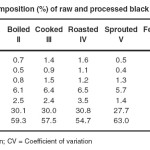 |
Table 1: Fatty acid composition (%) of raw and processed black turtle bean seed flour Click here to View table |
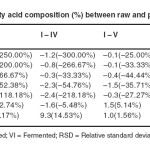 |
Table 2: Differences in the fatty acid composition (%) between raw and processed black turtle beans Click here to View table |
Table 2 displays the differences in the fatty acid composition between raw and boiled, between raw and roasted, between raw and sprouted and between raw and fermented samples. Capric (C10:0) and lauric (C12:0) acids recorded increase in the boiled, cooked, roasted and sprouted with a reduction in fermented samples while palmitic (C16:0) and stearic (C18:0) recorded an increase in all the processing methods. Linoleic as one of the unsaturated fatty acid and had the highest decrease in all the processing methods (boiling, cooking, roasting, sprouting and fermenting) of 7.34, 10.17, 14.56, 1.56 and 0.47%, respectively which is in perfect agreement with observation made for red kidney seeds. Oleic acid the second unsaturated fatty acid had an increase ranging from 2.74% in cooked to 5.48% in roasted samples and a reduction of an equivalent value of 5.14% in sprouted and fermented seed samples. The slight changes in boiled, cooked and roasted seeds may be due to the effect of thermal cracking on the fatty acid composition while that of sprouted and fermented seeds may be due to metabolic activity taking place in the seeds18. CV% was variously varied with a range of 26.15 in oleic acid to 122.50% in capric acid.
The distribution of results in Table 1 into TSFA, MUFA, DUFA, TUFA, TEFA and oleic to linoleic (O/L) is shown on Table 3. TSFA ranged from 8.6% in fermented to 13.9% in roasted samples with an average of 10.32±2.35% and coefficient of variation of 22.77%. These values are lower than TSFA mean value (31.3%) of pigeon pea15 and Hausa melon seed (28.9%)19. Total unsaturated fatty acids (TUFA) which make ω–9 and ω–6 fatty acids ranged from 85.5 to 91.4%. The ω–3 and ω–6 fatty acids in the diet can be of considerable importance20 but ω–3 fatty acid was not present in all the samples. However, the high content of TUFA in this study is great concern because it has been reported that fats and oils which contain more unsaturated fatty acids are particularly susceptible to oxidation, and intake of food containing oxidized lipids increased the concentration of secondary proxidation products in the liver21. Linoleic and α–linolenic acids are the most important essential fatty acids required for growth, physiological functions and body maintenance17. Linoleic acid is the only available essential fatty acid in this study ranging from 54.7% in roasted to 63.7% in fermented samples; therefore the raw and processed seeds of black turtle bean will participate well in those functions. It has also been reported that polyunsaturated linoleic acid moderately reduced serum cholesterol and low density lipoprotein (LDL) levels20. The oleic/linoleic (O/L) acids ratio has been associated with high stability and potentiality of the oil for deep frying fat22. The O/L levels in the present present study ranging from 0.4 to 0.5 are lower than peanut oil (1.48)22. Hence black turtle bean oil may also not be useful as frying oil. The CV% ranged from 2.86 in TUFA to56.64% in TEFA%.
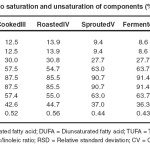 |
Table 3: Fatty acid distribution according to saturation and unsaturation of components (%) in raw and processed black turtle bean Click here to View table |
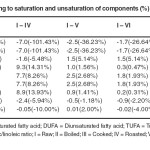 |
Table 4: Differences in the distribution according to saturation and unsaturation of components (%) between raw and processed black turtle beans Click here to View table |
Physicochemical Properties of Black Turtle Bean Oil
The physicochemical property of black turtle bean oil is presented on Table 5. The saponification value obtained for the raw black turtle seed oil (190.50 mgKOH/g) is higher when compared with the 106.6 mgKOH/g for Persea gratesima23 and 108.27 mgKOH/g for Luffa cylindrical14. All the processing methods enhanced the saponification values ranging from 192.50 mgKOH/g in boiled sample to 198.02 mgKOH/g in roasted sample. These high values indicate that the oil contain high proportion of lower fatty acids24.
The peroxide values (3.20–3.40 meq/kg oil) are higher than those from Africa walnuts oil (1.42 and 1.99 meq/kg oil) Prosopis africana oil (1.61 meq/kg oil) but lower than 20 me/qkg for Luffa cylindrical14. Peroxide value is an indication of deterioration of oil25. The peroxide value of 3.2 meq/kg placed the oil within the stipulated permitted maximum level of not more than 10 meq/ kg oil. This suggests that it is not highly susceptible to lipid oxidation. Iodine value indicates extent of unsaturation of the fatty acids present in the fat. The value in this report is higher than 100 g/100g expected maximum level therefore the oil would not be stable as drying oil. All the processing methods reduced the iodine value. The trend is such that raw > boiled > fermented > cooked > sprouted > roasted. The acid value compared well with the value obtained for African walnut oil (11.95 and 12.67 mg KOH/g).The value 10.02 mgKOH/g of the oil is higher than the reported values of 1.96% for Afzelia africana seed oil, 3.36% African pear, 2.96% paprispka seed oil, 3.90-4.41%. Tetracarpidinm conophorum oil, 3.99-4.10 of raw linseed oil, 1.6% perilla oil but lower than 35.46% African star apple (Chysophyllum africana), 13.40 of Horse eye bean and 14% of Velvet tainarind26 – 27. The specific gravity of 0.959 obtained indicates that the oil is less dense than water. The value obtained for the raw was 3.92 meq/kg. The value was lower than values for Nigeria palm kernel (1.42 and 1.19 meq/kg). However, the values are still within expected values indicating that the oil can be kept for sometime without much deterioiation (that is it is not highly susceptible to lipid oxidation). The value of 3.92 meq/kg oil falls within the stipulated permitted maximum level of not more than 10 meq/kg oil.
The iodine value is the measure of the extent of unsaturation in the oil. It also helps to place the oil as stable, non-drying oil. The iodine value in this study ranged from 123.48 unit in sprouted sample to 134.25 mgI/g in boiled sample. The values are higher than those reported for red kidney bean (89.4mg iodine/g)5, Proposis africana (59.94 g/100g)28 but lower than those for Citrullus vulgaris (38.1 ± 3%)29 and Hausa melon seed (38.50 ± 0.67%)30 Since drying oils have iodine value above 10031. Black turtle bean oil can be regarded as drying oil.
Antinutritional Composition of Black Turtle Bean Seeds
Table 8 presents the anti nutrients of the black turtle bean. The saponin content ranged from 2.50% in boiled sample to 13.00% in fermented sample. The value for the raw (13.20%) compared well with values for pinto (13.00%) and red kidney (14.00%) in this work but have higher value than the ones reported by many authors such as Sesbania seeds (0.50–1.46%)32, 0.05 and 0.23 reported for mung beans and chickpeas, respectively33. Saponin has been shown to possess both deleterious properties and to exhibit structure dependent biological activities33. The level of tannin in the black turtle seed ranged from 111.75% in the boiled seeds to 124.70% in the cooked, roasted, sprouted and fermented samples. The value is extremely higher than values reported for Sesbania seeds (1.97–2.25%)32.
The nutritional effects of tannins are mainly related to their interaction with protein due to the formation of complexes34. Tannin–protein complexes are insoluble and protein digestibility is decreased35. Tannin acid may decrease protein quality by decreasing digestibility and palatability. Other nutritional effects which have been attributed to tannin include damage to the intestinal tract, interference with the absorption of iron and a possible carcinogenic effect36. The alkaloid content ranged from 1.00% in fermented to 1.80% in boiled sample. Alkaloids cause gastrointestinal and neurological disorders. The values in this research are within the limit since it is below 20 mg/100g which is the limit. Phytic acid content ranged from 37.50 mg/g in the sprouted to 112.50 mg/g in boiled. The 112.50 mg/g obtained for the raw sample is higher than values reported for soybean (40.5 mg/g), pigeon pea (11.7 mg/g) and cowpea (20.4 mg/g)37. Phytic acid is an important storage form of phosphorus in plant, it is insoluble and cannot be absorbed in human intestine and it has 12 replacaeble hydrogen atoms with which it could form insoluble salts with metals such as calcium, iron. zinc and magnesium. The formation of these insoluble salts renders the metals unavailable for absorption into the body. Phytate can also affect digestibility by chelating with calcium or by binding with substrate or proteolytic enzyme. Phytate is also associated with cooking time in legumes38. Oxalate presented in this work (1668.90 mg/g) is lower than 2257.40 mg/g found in red kidney bean (2257.40 mg/g) and higher than pinto (1481.60 mg/g) in this present work but also higher than 2.54 mg/g for soybean, 2.86 mg/g (pigeon pea)37.
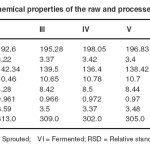 |
Table 5: Physicochemical properties of the raw and processed black turtle bean Click here to View table |
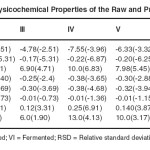 |
Table 6: Difference in the Physicochemical Properties of the Raw and Processed black turtle Bean Click here to View table |
Oxalate is produced and accumulated in many crop plants and pasture weeds. Oxalate is a concern in legumes because high oxalate diets can increase the risk renal calcium absorption since calcium is made unavailable to the body due to the presence of oxalate39. Cyanide was not found in all the food samples. Trypsin inhibitors have been found in legumes to inhibit the activity of digestive enzymes hence causing poor utilization of the protein in most legumes40. The value obtained for the raw sample was 150 mg/g and ranged from 120 mg/g in fermented to 240 mg/g in boiled indicating a very high value. Researchers observed that those legumes which had the highest trypsin inhibitor activity were those in which the digestibility, as measured in in–vivo with rats, was most improved by cooking. They depress animal growth by interfering with the digestion and absorption of nutrients in the gastrointestinal tract41. Cyanogenic glycosides ranged from 0.0000155 mol/dm3 in fermented sample to 0.0000464 mol/dm3 in raw sample. The value for the raw 0.0000464 mol/dm3 is very low but compared to values reported for red kidney and pinto bean seeds. This is known to cause acute or chronic toxicity. Cyanogenic glycoside on hydrolysis yield toxic hydrocyanide acid (HCN). The cyanide ions inhibit several enzyme systems; depress growth through interference with certain essential amino acids and utilization of associated nutrients42.
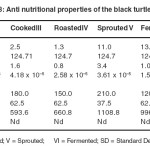 |
Table 8 Anti nutritional properties of the black turtle bean Click here to View table |
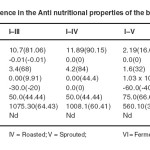 |
Table 9: Difference in the Anti nutritional properties of the black turtle bean Click here to View table |
REFERENCES
- Alais, C. and Linden, G. Food Biochemistry. Aspen Publisher, Inc. Gaithersburg, Maryland, pp. 14 – 15 (1999).
- Aremu, M. O., Olaofe O., Basu, S. K., Abdulazeez, G. and Acharya, S. N. Processed cranberry bean (Phaseolus coccineus) seed flours for African diet. Canadian J. Plant Science, 90: 719 – 728 (2010).
- Olaofe, O. and Sanni, C. O. Mineral content of agricultural products. Food Chem., 30: 73 – 77 (1988).
- Copeland, L. O. Principles of sed. science and technology. Bourgeoss Pub. Comp., pp. 37 – 53 (1976).
- Olaofe, O., Famurewa, J. A. V. and Ekuagbere, A. O. (2010). Chemical and functional properties of kidney bean seed (Phaseolus vulgaris L.) flour. Int. J. Chem. Sci., 3(1): 51 – 69.
- I. Alim, H. Arora and Md. Rafi, Orient. J. Chem., 26(1): 259-2626 (2010).
- Giami, S. Y. and Bakebain, O. A. Proximate composition and functional properties of raw and processed full fat fluted pumpkin (Telfaria occidentails) seed flour. J. Sci. Food Agric., 59: 321 – 325 (1992).
- Akintayo, E. T. and Bayer, E. Characterization and some possible uses of Plukenetia conophora and Adenopus brevilorus seeds and seed oils. Bioresource Tech., 85: 95 – 97 (2002).
- AOAC Association of Analytical chemist official method of Analysis (15th edn) Washington DC, 650 – 671 (1990).
- Day, R. A. (Jnr) and Underwood, A. L. Quantitative analysis, 5th Edn. Prentice–Hall Publication, p. 701 (1996).
- Obadoni, B. O. and Ochuko, P. O. Phytochemical studies and comparative efficacy of the crude extracts of some plant in Edo and Delta States of Nigeria. J. Pure Appl. Sci., 203 – 208 (2001).
- Audu, S. S. Aremu, M. O. and Lajide, L. Effect of processing on fatty acid composition of pinto bean (Phaseolus vulgaris L.) seeds. Int. J. Chem. Sci., 4(1): 114 – 119 (2011).
- Paul, A. A. and Southgate, D. A. T McCance and Widdowson’s The Composition of Foods. HMSO/Royal Society of Chemistry, London, pp. 65 – 70 (1985).
- Ihekoronye, A. I. and Ngoddy, P. O. Integrated Food Science and Technology for the Tropics. Macmillan, London, UK (1985).
- Aremu, M. O. and Amos, V. A. Fatty acids and physicochemical properties of sponge luffa (Luffa cylindrica) kernel oils. Int. J. Chem. Sci., 3(2): 166 – 171 (2010).
- Osagie, A. U. Okoye, W. I., Oluwayose, B. O. and Dawodu, O. A. Chemical quality parameters and fatty acid composition of oils of some underexploited tropical seeds. Nig. J. Appl. Sci., 4: 151 – 162 (1986).
- Lee, F. A., Mattick, L. R. Fatty acids of the lipids of vegetables I: peas (Pisum sativum). J. Food Sci., 26: 273 – 275 (1961).
- Salunkhe, D. K., Kadam, S. S. and Chavan, J. K. CRC post–harvest biotechnology of food legumes. Boca Raton, FL, CRC Press (1985).
- Aremu, M. O., Olayioye, Y. E. and Ikokoh, P. P. Effect of processing on the nutritional quality of Kerstingella geocarpa seed flour. J. Chem. Soc. Nig., 34(2): 140 – 149 (2009).
- Aremu, M. O., Olaofe, O., Akintayo, E. T. A comparative study on the chemical and amino acid composition of some Nigerian under–utilized legume flour. Pak. J. Nutri., 5(1), 34–38 (2006).
- WHO/FAO. Fats and Oil in Human Nutrition (Report of a Joint Expert Consultation), FAO Food and Nutrition. Paper 57, Rome: WHO/FAO (1994).
- Hegsted, D. M., Ausman, L. M., Johnson, J. A. and Dallal, A. J. Dietary and serum lipids. An evaluation of the experimental date. Am. J. Clin. Nutr., 57: 875 – 885 (1993).
- Branch, W. D., Nkayama, T., Chennan, M. S. Fatty acid variation among US runner type peanut cultivars. J. Am. Oil Chem. Soc., 67: 591 – 596 (1990).
- Akubugwo, I. E., Chinyere, G. C. Ugbogu, A. E. Comparative studies on oils from some common plant seeds in Nigerian. Pak. J. Nutr., 7(4): 570 – 573 (2008).
- Pearson, D. Chemical Analysis of Foods, 6th ed. Churchill Livingstone, London, pp. 6 – 9 (1976).
- Aremu, M. O., Mamman, S. and Olonisakin, A. Evaluation of fatty acids and physicochemical characteristics of six varieties of bambara groundnut (Vigna subterranea L. Verdc.) seed oils. La Rivista Italiana Delle Sostanze Grasse, 90: 107 – 113 (2013).
- Ajiwe, V. I. E., Okeke, C. A. and Agbo, H. U. Extraction and Utilization of Afzelia africana seed oil. Bores. Tech., 47: 85 – 86 (1995).
- Enwere, N. J. and Hung, Y. C. Some chemical and physical properties of bambara groundnut seed and products. Int. J. Food Sci. Nutri., 47: 469 – 475 (1996).
- Umerie, S. C., Okafor, E. O. and Uka, A. S. Evaluation of the tubers and oil of Cyperus esculentus. Biores. Technol., 61: 171 – 173 (1997).
- Achinewhu, S. C. Nuts and seeds, In: Nutritional quality of plant foods. Osiegie, A. U. and Offiong, U. E. (Eds), pp. 134 – 159 (1998).
- Oladimeji, M. O., Adebayo, A. O. and Adegbesan, A. H. Physicochemical properties of Hausa melon seed flour. Ulitra Sci., 13: 374 – 377 (2001).
- Aremu, M. O., Olaofe, O., Akintayo, E. T. and Lajide, L. Characterization of some under–utilized legume seed oils by NMR spectroscopy. Oriental J. Chem., 23(1): 81 – 87.
- Hossain, M. A. and Becker, K. Nutritive value and anti–nutritional factors in different varieties of sesbania seeds and their morphological fractions. Food Chem., 73: 421 – 431 (2001).
- Prince, K. R., Johnson, I. T. and Fenwick, G. R. The chemical and biological significance of saponins in foods and feeding stuffs. Critical Reviews in Fd. Sci. and Nutri., 26: 35 (1987).
- Laurena, A. C., Van, T. and Mendoza, M. A. T. Effects of condensed tannins on the in-vetro digestibility of cow pea (Vigna unguiculata). J. Agric Food Chem., 32: 1045 – 1049 (1984).
- Carnovale, E., Lugaro, E. and Marconi, E. Protein quality and anti–nutritional factors in wild and cultivated species of Vigna spp. Plant Food for Human Nutrition, 4: 11 – 20 (1991).
- Butler, L. G. Effects of condensed tannins on animal nutrition. In: Chemistry and Significance of Condensed Tannins. Hemingway, R. W., Karchesy, J. J. Eds. Plenum Press, New York, pp. 391 – 402 (1989).
- Aletor, V. A. and Omodara, A. O. Studies on some leguminous browse plants, with particular reference to their proximate, minerals and some endogenous antinutritional constituents. J. Ani. Feed Sci., 46: 343 – 348 (1994).
- Nwokolo, E. N. and Bragg, D. B. Influence of phytic acid crude fiber on the availability of minerals from four protein supplements in growing chicks. Can. J. Ani. Sci., 57: 475 – 477 (1997).
- Libert, B. and Franceschi, V. R. Oxalate in crops plants. J. Agric Food Chem., 32: 1056 – 1062 (1987).
- Liner, I. E. Toxic Constituents of Plant Foodstuffs, 2nd edn. Academic Press, New York, NY (1980).
- Aletor, V. A. and Fetuga, B. L. Pancreatic and intestinal amylase (EC 3.2.1.1) in the rats fed haemagglutinin extract II. Evidence of impaired dietary starch utilization. J. Anim. Physiol. Anim. Nutr., 57(3): 113 – 117 (1987).
- Osuntokun, B. O. Cassava diet chronic cyanide metabolism in wistar rats. Brit. J. Nutr., 24: 797 – 805 (1972).

This work is licensed under a Creative Commons Attribution 4.0 International License.









